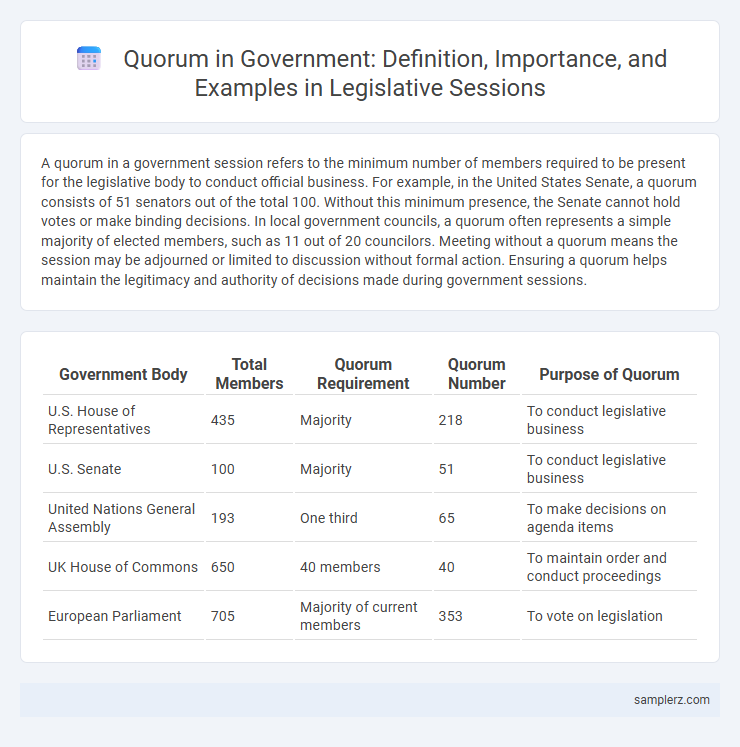A quorum in a government session refers to the minimum number of members required to be present for the legislative body to conduct official business. For example, in the United States Senate, a quorum consists of 51 senators out of the total 100. Without this minimum presence, the Senate cannot hold votes or make binding decisions. In local government councils, a quorum often represents a simple majority of elected members, such as 11 out of 20 councilors. Meeting without a quorum means the session may be adjourned or limited to discussion without formal action. Ensuring a quorum helps maintain the legitimacy and authority of decisions made during government sessions.
Table of Comparison
| Government Body | Total Members | Quorum Requirement | Quorum Number | Purpose of Quorum |
|---|---|---|---|---|
| U.S. House of Representatives | 435 | Majority | 218 | To conduct legislative business |
| U.S. Senate | 100 | Majority | 51 | To conduct legislative business |
| United Nations General Assembly | 193 | One third | 65 | To make decisions on agenda items |
| UK House of Commons | 650 | 40 members | 40 | To maintain order and conduct proceedings |
| European Parliament | 705 | Majority of current members | 353 | To vote on legislation |
Understanding the Concept of Quorum in Government Sessions
Quorum in government sessions refers to the minimum number of members required to be present for the body to conduct official business, typically defined by a specific portion of the total membership, such as a majority. For example, in the U.S. House of Representatives, a quorum is met when 218 out of 435 members are present, ensuring decisions represent a substantial portion of the elected body. Understanding quorum is essential to maintain legislative legitimacy and prevent actions taken without adequate member participation.
Importance of Quorum for Official Deliberations
Quorum, typically defined as a majority of members such as 51 out of 100 senators in the U.S. Senate, ensures that official deliberations represent the collective judgment rather than a small minority. This minimum attendance requirement underpins the legitimacy of decisions, preventing any single faction from unilaterally passing legislation without sufficient oversight. The importance of quorum safeguards transparency, democratic accountability, and the effective functioning of legislative bodies during sessions.
Quorum Requirements in Legislative Bodies
Quorum requirements in legislative bodies vary but typically mandate that a majority of members be present to conduct official business, ensuring decisions reflect a representative consensus. For example, the U.S. House of Representatives requires at least 218 members out of 435 to establish a quorum for legislative sessions. State legislatures often set their own quorum thresholds, commonly ranging from a simple majority to two-thirds of members, to maintain order and legitimacy in governance.
Example: Quorum in a National Parliament Session
A quorum in a national parliament session typically requires more than half of the total members to be present to conduct official business, such as voting on legislation or debating policy. For instance, in the United Kingdom's House of Commons, a quorum is set at 40 members out of 650, ensuring meaningful participation while maintaining legislative efficiency. Failure to meet this quorum results in suspension of the session until enough members are present to validate decisions.
Quorum Application in Local Government Meetings
Quorum in local government meetings typically requires a majority of elected members to be present to validate proceedings, such as a city council meeting where at least half plus one of the councilors must attend. This rule ensures decisions, including budget approvals and ordinance enactments, reflect a representative consensus. The application of quorum rules varies by jurisdiction but consistently upholds transparency and accountability in local governance.
Case Study: Quorum in City Council Proceedings
In the case study of quorum in city council proceedings, a minimum of half the total council members plus one must be present to legally conduct business, ensuring decisions reflect a representative majority. For instance, in a council of 10 members, at least 6 must attend sessions to meet quorum requirements. This quorum rule prevents unilateral actions and upholds the integrity of democratic governance in municipal operations.
Consequences of Failing to Meet Quorum
Failing to meet quorum in a government session results in the inability to legally conduct votes or pass legislation, causing delays in decision-making and policy implementation. This disruption can stall critical government functions and erode public trust by signaling inefficiency or disorganization. Persistent quorum failures may trigger procedural sanctions or compel rescheduling, impacting legislative agendas and governance stability.
Strategies to Ensure Quorum in Government Sessions
Governments implement strategies such as mandatory attendance policies and real-time quorum monitoring systems to ensure quorum in legislative sessions. Utilizing digital roll calls and automated alerts helps maintain the minimum number of members required for valid decision-making. Enforcing strict attendance consequences and scheduling sessions during optimal times further guarantees consistent member presence.
Legal Implications of Quorum Violations
A quorum in a government session typically requires a majority of members, such as 218 of 435 in the U.S. House of Representatives, to conduct official business and pass legislation. Violating quorum rules can invalidate legislative decisions, leading to legal challenges or nullification of enacted laws, which undermines the legitimacy of governmental authority. Courts have ruled that proceedings without a proper quorum violate constitutional provisions, emphasizing the critical role of quorum in maintaining lawful governance.
Global Variations in Quorum Standards
Quorum requirements in government sessions vary significantly worldwide, with some countries demanding a simple majority to conduct legislative business, while others require a two-thirds or even higher presence to ensure comprehensive representation. For example, the United States House of Representatives mandates a quorum of 218 members out of 435, whereas the UK House of Commons requires just 40 members to proceed with debates. These global variations in quorum standards reflect differing approaches to balancing efficiency and inclusivity in parliamentary governance.

example of quorum in session Infographic
 samplerz.com
samplerz.com